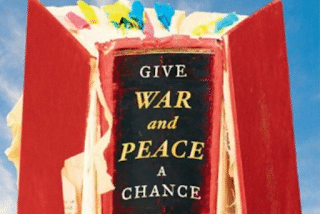A few months ago I was on a crowded train with my son. We were standing, and as the train pulled off, a Singaporean man stood, called me uncle in that respectful Asian way of addressing older generations, and offered me his seat. I was surprised as the man looked (to me) to be not far from my own age, but it seemed churlish to refuse, so I thanked him and sat – and the smile on my son’s face told me he knew what was going through my mind. When we spoke about it later on and I wondered if I might have looked a little unsteady for some reason, he provided an alternative and perhaps more accurate explanation: Maybe you just look older than you think. That had the ring of truth; sometimes we see one person in the mirror but the world sees another.
It’s the difference between information and stories. The man who generously offered me his seat had information about me (what he could see) whereas I have a whole story about myself, that not only includes some information (my age, physical condition etc) but also my perception of myself, and my feelings about aging and my (unspoken) expectations about being offered a seat. Neither is wrong, but they are quite different, and the difference explains my rather grumpy reaction. It was about me, not about him.
This difference between information and stories seems to me to extend far beyond this trivial example, because both information and stories are increasingly problematic. The familiar issue of information overload is being compounded by increasing distrust of media, flagrant mistruths and AI; furthermore, the stories that were once widely shared between groups have now been splintered and broken, and to fractured factions with very different stories – frequently leading to blood-sport politics, with all the attendant woes we see in so many countries.

Inspired by Han Byung-Chul’s and Nicholas Carr’s latest books The Crisis of Narration and Superbloom, I want to suggest that we can conceptualise this idea in this way: Accelerated communication means that information has squeezed out stories.This is not a straightforward idea, and indeed it flies in the opposite direction to the widely held notion that increased communication and shared information would be wholly positive, even stopping conflict and leading to peace. Carr traces the history of this positive view:
- 1898: Nikola Tesla, said that when he developed the wireless telegraph, he would be remembered as the inventor who succeeded in abolishing war.
- 1912, Guglielmo Marconi, said his invention of radio would make war impossible.
- 1923: J. J. Carty, of AT & T’ predicted that the telephone system would join all the peoples of the earth in one brotherhood.
- 1932, Orrin Dunlap, technology writer, said that television would usher in a new era of friendly intercourse between the nations of the earth.
This utopian idea has not gone away. In 2012 Mark Zuckerberg wrote that Facebook was…built to accomplish a social mission — to make the world more open and connected…. we’re inspired by technologies that have revolutionized how people spread and consume information. … They gave more people a voice. They encouraged progress. They changed the way society was organized. They brought us closer together. We hope to strengthen how people relate to each other.
That said, it’s also true that there have always been (rarer) contrary impulses. Carr also notes:
- 1917 British diplomat Ernest Satow wrote The moral qualities— prudence, foresight, intelligence, penetration, wisdom—of statesmen and nations have not kept pace [with the] rapidity of communication by telegraph and telephone.. These latter leave no time for reflection or consultation, and demand an immediate and often a hasty decision on matters of vital importance.
- 1947: Canadian Professor Harold Innis wrote Enormous improvements in communication have made understanding more difficult.
So these ideas have been around for a long time, and Carr argues that we have moved from the first positive view, to the second, negative one, because the sheer exchange of messages and information …actually overwhelm[s] the mind’s ability to make sense of it all in a deep way. To keep up with the flow, people have to sacrifice emotional and intellectual depth. We become re-active and impulsive, and that ends up triggering misunderstanding and animosity and, in general, misanthropy.
Perhaps this is the inevitable outcome of information technology. When in Homer’s Odyssey, Odysseus said to his son the blade itself incites to deeds of violence he meant that the intrinsic nature of some technologies makes certain outcomes more likely (similar in thrust to Marshal Mcluhan’s idea that the medium is the message). Or perhaps it’s just that any good idea taken to it’s extremes becomes self-subverting. Either way there is no doubt there is a problem here.
Han addresses this in his Crisis of Narration, arguing we need a big picture, an overarching account that means we can have confidence in our own values. Put it another way, we need to re-create common stories and shared narratives that bind groups of people together. Schools and families have as much of a role to play as Governments and institutions; perhaps even more so when the latter are being weakened around the world.
Han’s analysis is that narrative arises from community and interpersonal relationships. He suggests that shared understandings used to come by telling stories, and that required time, attention and presence – all of which have been displaced: The days of gathering around a fire to share stories have long passed. That communal fire has been replaced by digital screens, which isolate individuals as lonely consumers. These screens do not foster community, nor do the so-called stories shared on social media fill the narrative void. In our era of accelerated communication, we lack the time or patience to tell stories; we merely exchange information.
Without narrative, we are buffered by the overwhelming and relentless tsunami of information. But as Han says, Information lacks depth and expanse; it cannot capture rough winds or dazzling sunshine. Narratives allow us to find shared meaning and identity, which do not arise when we have only information. The shared narratives that are under attack, and that we desperately need to retain are things like trust in government, belief in the goodness of others, a sense that progress is possible, a respect for expertise, the idea that life is not a zero-sum game, and so on. But there are darker alternatives. Writer Mckay Coppins suggests that the narrative driving force behind American politics today is not allegiance to higher democratic ideals, or even partisanship, but either whim and self-interest or actually negative partisanship—that is, hatred of the other team more than loyalty to one’s own.
What does this all mean for our students and school?
- That we take time to metaphorically gather around a fire to share stories which means pedagogies that foreground differences of perspective, time to make sense of ideas not just absorb information, scaffolded discussion and collaboration not atomised mastery of content. It means classroom practices that allow individuals to bring their own values and dreams into the conversations.
- That we also understand why we are sharing stories. Without the reasons, it would be easy to see stories as the ‘fluffy stuff’ that gets in the way (and indeed there are educational movements around the world that see it exactly that way). So they need to be aware of role of stories, and of narrative; which entails the need to hold multiple competing perspectives about factual matters as we would for stories.
- That we create stories that bind us to a common humanity, through our own bespoke curricula that weave these ideas through the K-12 education experience in age appropriate ways. We’ve always done that; we have several exciting ongoing initiatives to develop this further, and it’s why we see the human stories offered by the Arts as important as STEM.
- That we see no trade-off between on the one hand developing the intellect to find the best positions in complex matters, and the humility to recognise that no one has a monopoly on truth on the other.
- That we continue to seek to encourage the virtue for students to act not just for themselves, but for others too – and especially the most needy and vulnerable.
The deeply moral value of stories should emerge from all this; and once we understand that our own story is just one of around eight billion (today), it should foster intellectual humility as well as sophistication. It should allow us to hold, as Scott Fitzgerald wrote, opposed ideas at one and still be able to function. The sentence that follows the famous quote in the graphic above is not often mentioned, but seems particularly pertinent today:
One should, for example, be able to see that things are hopeless and yet be determined to make them otherwise.
All this adds up to an overarching human narrative; and the one that we seek to build contains these elements: That there is more to life than narrow self-interest; that the world has limited resources, and we will all suffer if we misuse them, so we have an enlightened self-interested duty to preserve them; that we will maximise our chances of success by seeking personal and interpersonal peace; that war is a tragedy and a failure. And peace at any level is best sought through painstaking but effective win-win deliberations.
References
- Blodget, H (2012) Hey, Wall Street, Mark Zuckerberg Already Told You Everything You Need To Know About Facebook. Businessweek.
- Carr, N (2025) Super bloom: How Technologies of Connection Tear Us Apart. W. W. Norton and Company
- Coppins, M. (2018) The Man Who Broke Politics.The Atlantic
- Edsall, T (2018) What Motivates Voters More Than Loyalty? Loathing. New York Times
- Han, Byung-Chul (2024) The Crisis of Narration. Polity Press


